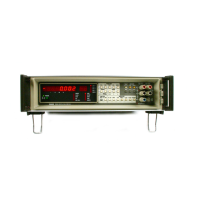8505A
2-115.
Hardware calibration is facilitated
while in
Calibration
mode. Enhanced resolution
allows for more
precise potentiometer adjustment during
hardware
calibration. With no mathematic
operations allowed, the
display
represents the true input
value.
2-116.
Troubleshooting is also aided
by using the
Calibration
mode. Latching
errors can be disabled
to
allow
special module configurations.
CAUTION
Latching errors are intended
for multimeter
protection and must not
be
disabled
during
normal operation or calibration. Refer
to
Troubleshooting in Section 4.
2-117.
USE
2-118.
The multimeter uses three calibration controls:
the rear
panel calibration switch,
and the front panel
(CAL DATE) and (CAL COR) push buttons.
The rear
panel calibration switch activates the Calibration
mode
and enables use of the (CAL COR) and (CAL DATE)
push buttons.
Store operations
with these two push
buttons are used for software calibration
and are
explained in Appendix 7B. Recall operations
can be
performed at any
time and
are explained in the following
paragraphs.
2-119.
The (CAL DATE) push button can
be used in all
functions to recall a six
digit
number.
This
number
may
signify the calibration date. For example,
a recalled
0218
8
3 would signify February
18,
1983. Alternately,
the six
digits may be used to identify the multimeter.
2-120.
To recall the six digit
date (or identifier)
while in
the Calibration
mode, push RECALL
(CAL DATE).
If
the multimeter is not in the Calibration
mode,
the six digit
date (or identifier) can be recalled
using RECALL.
LO
(CAL DATE).
2-121.
The (CAL COR) push
button may be used to
recall the uncorrected reading when
the multimeter is in
the Calibration mode,
use:
RECALL (CAL COR)
The uncorrected reading can
also be recalled when
the
multimeter is not in the Calibration
mode. Use the
following sequence:
RECALL
LO (CAL COR)
2-122. Scan
Advance
2-123.
The multimeter outputs
a
sync signal
during each
measurement
sequence. This signal occurs after the
measurement is
complete, but before a new trigger is
accepted. The sync signal thereby allows for
faster bus
communications
by advancing a scanner before a new
reading is triggered. The
signal (positive going TTL, 3
microsecond
pulse width, 50-ohm output impedance)
is
available
at a BNC connector on the multimeter rear
panel.
2-124.
Systems
Use
2-125.
The
availability
of optional interface
modules
makes the multimeter adaptable to
a
large
variety
of
digital systems. Operating
and programming
instructions
related to remote operation are
included
with the
appropriate
optional module.
2-126.
OPERATION
2-127.
Initial Turn-On
2-128. Before initial turn-on,
check that
the line voltage
specified on the rear panel sticker
(near the line
fuse)
agrees
with the line
voltage actually being
used. If there
is
any doubt concerning the line voltage
setting,
refer
to
Line Voltage Selection in Section 4.
Also verify
that the
Calibration switch is off. Once these
verifications
have
been made, connect the power cord
and push
the
POWER button
to
ON.
2-129.
The multimeter identifies
its own
software
and
hardware at initial turn-on. Software
is identified
with
a
display of “HI
-
Y.Y.Y”, where
“Y” represents
the
software version in use. Hardware
is then identified
with
a
display of “CXXXXX”, where “X”
signifies any
installed
options by number.
2-130.
Power-up (reset) configuration
is
now
established. The function
is set for
V
DC, the
I000V
range
is set, along
with
filter F0, sample
7,
auto trigger,
zero
mode
on,
and
local operation. All other
modes and values
are disabled, The multimeter may
now be
programmed
as
described in
this Section. A two-hour warm-up
insures
rated accuracy. Better
accuracies
can
be obtained
in
the
Average mode after
a
four-hour warm-up.
2-131.
Measurement Instructions
2-132.
Use the following procedures
when
making
measurements from the
front panel:
1. Remove multimeter inputs.
2.
Select the desired function.
3.
Referring to Figure
2-3, set
measurement
parameters.
4. Further
programming from
the front
panel is
often not
necessary. If no mathematic
operation
or
special
operations are desired,
proceed to
Step 6.
5.
If mathematic
or special operations
are desired,
refer
again to the guidelines in Figure
2-3.
6.
Position the measurement terminal
controls
(right of
terminals)
as
required.
The Rear Input
Selector must be disengaged (out)
if the front panel
inputs are being used. The Ohms
Selector must be
engaged (in) when four-wire resistance
measurements are being made. The
Guard Selector
is normally left disengaged (out) for non-critical
measurements. Refer to Measurement
Terminals
and
Controls in this Section
for other uses
of
these
selectors.
2-25

